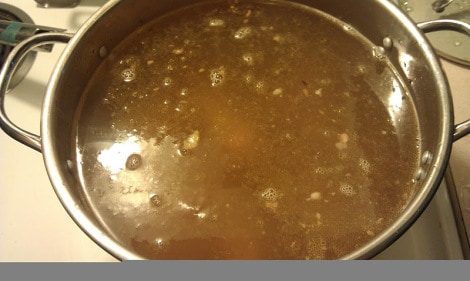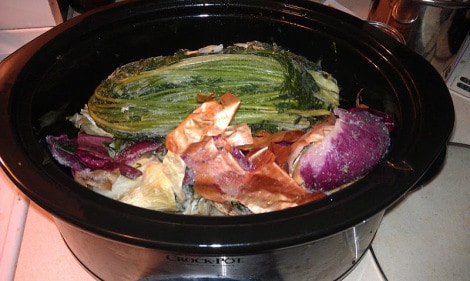Homemade Broth / Stock
Using bouillon is a no-no on a low amine diet. I find organic carton broth to be marginally better, but it’s all still been sitting around on a shelf for a long time, collecting amines in my food. Not my favorite. Making your own broth at home is super simple and very economical. I keep (and re-use – yay recycling!) a few bags of scraps in my freezer until I have enough to make whatever kind of broth I’m making.
I typically have several gallon-sized Ziplock bags of “trash” in my freezer at any given time:
- Scraps, bones, and fat from lamb, buffalo, and beef
- Scraps, bones, and fat from chicken
- Shrimp and other mollusk shells, tails, etc. If making fish stock, I acquire bones and scraps and make it same day, and use it same day, as fish grows amines very quickly.
- Vegetable bits, including:
- carrot tops
- onion skins, tops, bottoms (too many onion skins will make it bitter)
- ends of parsley
- bits of unused potato or beet root
- beet tops (if I didn’t cook and eat them)
- stemmy or fibrous bits
- asparagus stem bottoms
- vegetables that haven’t gone bad, but aren’t at their peak and won’t get used
- any other low amine vegetable bit or scrap.
When I have a full gallon Ziplock, I’m ready to make stock. I use either a Crockpot, or do it on the stove. Either way works just fine, though stovetop is much faster.
- Fill pot/Crockpot with whatever foods from which you’re making stock.
- Pour in enough water to cover everything.
Beef broth starting on the stovetop
Making vegetable broth in the Crockpot
- Meat broth: Add 1 Tbsp vinegar to the stock. It helps pull calcium and other nutrients out of the bones.
- On the stove top, I turn it to high and once boiling, turn to a very low simmer. Cook for at least hours. The longer you cook it, the more it will flavor the broth.
- In a Crockpot, I usually run it for two cycles (6 hours each cycle) on high.
- Allow to cool.
- Meat broth: Skim a majority of the fat and foam off the top (Fat is flavor and as much as America is anti-fat, it’s not bad for you in moderation. No need to be 100% on the skimming). Discard.
- Strain into another large pot.
- Meat broth: Discard bones. If there is any meat, throw it back in the pot with the stock.
- Vegetable broth: Squeeze broth out of remaining vegetable matter. Discard used vegetable scraps.
- You can reduce your stock if you’d like, for more compact freezer storage. I just pour it into a new Gallon Ziplock (you don’t want it leaking) and toss it in the freezer as is, since I usually use stock to make large batches of soup.
- You can also pour (this is better with a stock that has been at least partially reduced) it into ice cube trays, allow to freeze, and then put the bouillon cubes in a bag, if you want to use the stock in smaller amounts.
- Congratulations on being resourceful, healthier, and eating smarter. Enjoy your homemade stock!
47.606209 -122.332071Published in:
- Gluten-Free Low Amine Recipes
- Soy-Free Low Amine Recipes
- Vegan Low Amine Recipes
- Vegetarian Low Amine Recipes
on September 25, 2011 at 9:33 am Comments (36)
Tags: bouillon, Broth, Cook, Cooking, recipes, Slow cooker, stock
![]()
The URI to TrackBack this entry is: /2011/09/25/broth/trackback/
RSS feed for comments on this post.


